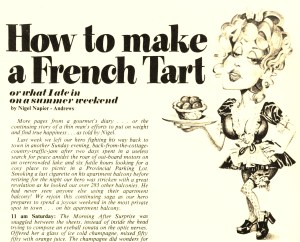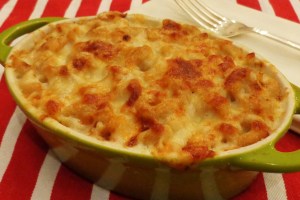It’s a cold winter Sunday and already the tans from a fortnight in the southern sun are fading, so what better dish to make for breakfast than quiche, filled with memories of lazy afternoons in the heat of a French summer. In fact, we are off to a late start so it is going to be brunch after all. I make the pastry and then while we enjoy a cup of tea with the New York Sunday Times spread all over the bed, the pastry chills. Contrary to the view espoused in the book that started it all – Real Men Don’t Eat Quiche – I don’t think I lack self-assurance. Indeed one needs a great deal of self-assurance to make any sort of pastry.
One of the first articles I wrote for the late Success magazine, was entitled (by the editor) “How to make a French tart.” Readers assumed I was being rude and giving advice on what to do on a dirty weekend in Paris. What I was really talking about is the true quiche, a pastry tart filled with creamy custard and bacon or ham, which comes from the French region of Lorraine. It is light and delicate so a small portion makes a great appetiser as equally as a large portion can constitute a main course. Back then I was buying frozen pastry shells, which will do in a pinch, but you can’t beat the taste of real pastry (see my blog on Jan 25 – The Life of Pie – for a never-fail recipe and a guaranteed touch of self-assurance).
QUICHE LORRAINE
Serves 4 to 6
Preparation time: 45 min
Cooking time: 35 min
Ingredients
9 in shortcrust pastry shell, partially baked
5 lean bacon rashers (or ham equivalent)
2 eggs plus 2 yolks
1 1/2 cups whipping cream
Salt and pepper
Pinch ground nutmeg
PAM spray
Weapons
9 in pie tin with removable bottom
sharp knife
mixing bowl
sauce pan
frying pan
baking rack
Preparation and cooking
1. Preheat the oven to 400°F/205°C. Push the pastry firmly into the corners of the lightly greased pie tin and then push aluminum foil down on top of it. Prick the foil right through the pastry with a fork to allow the air to escape. Bake for 10 min, then remove from the oven to a cooling rack, remove the foil and allow the pastry to cool a bit while you prepare the rest of the ingredients. TIP: With the proper 9 inch pie tin with a removable bottom, you can make a true quiche, where the sides are straight sided and stand supported only by the pastry shell. To ensure complete success, you can make the edges a bit thicker so they won’t collapse when you remove the outer ring of the tin.
2. Cut the bacon rashers into strips approx 1 in by 1/4 in and simmer in a saucepan of water for 5 mins. Remove, dry and then brown in a frying pan until brown. Set aside on a paper towel to drain the fat. Skip this step if you are using lean ham.
3. Prepare the filling: warm the cream in a saucepan, but do not boil. Take off the heat. Lightly beat the eggs and add to the mixture. Add salt, pepper and nutmeg and mix in well.
4. All the preparation is now done and apart from the final assembly, you will be eating in about 35 min. If this is too soon, leave all the ingredients separate for up to an hour and no harm will come. If the custard begins to separate a quick stir will rectify matters.
5. Reduce the oven to 375°F/190°C. Scatted the bacon over the bottom of the pie and slowly add the cream mixture until it almost reaches to top. If there is too much, discard it. Do not overfill the pie crust. Bake for 30 to 35 min, or until it is all puffed up, and golden brown on top.
6. To remove the pie from the tin, place it on a jar to push up the sides, which should easily fall away. Then slide the whole pie off the remaining metal disc onto a backing rack to set and cool a bit. TIP: Circulating air around the shell while it is cooling will prevent the pastry getting soggy on the bottom.
Vegetables
A green vegetable will add eye appeal, but should be something delicate in flavour, such as asparagus. Otherwise just serve a simple green salad.
Wine
From the area surrounding Lorraine come the white wines of Champagne, Alsace, the Rhine and Moselle, any of which would be appropriate. My own choice would be a fresh young Moselle in its slender green bottle, gently chilled.
CHEESE AND SPINACH QUICHE
Serves 4 to 6
Preparation time: 45 min
Cooking time: 35 min
You can really put almost anything you like into a quiche, such as onions, vegetables, seafood and more. Here’s a tasty alternative with cheese and spinach.
Ingredients
9 in shortcrust pastry shell, partially baked
3 large eggs
1 cup whipping cream + 1/4 cup milk
1/2 onion
1 clove garlic
1 package frozen chopped spinach (300g)
1 cup grated Gruyère cheese (200g)
Salt and pepper
Pinch ground nutmeg
1 tbsp butter (unsalted)
PAM spray
Weapons
9 in pie tin with removable bottom
sharp knife
mixing bowl
sauce pan
frying pan
baking rack
Preparation and cooking
1. Partially “blind” bake the pie shell at 400°F/205°C (see recipe above). Turn the oven down to 375°F/190°C while the pie shell cools.
2. Chop the onion finely and fry in the butter until translucent. Add the minced garlic and cook for another minute. Sprinkle over the bottom of the pastry.
3. Grate the cheese and add to the pie shell.
4. Thaw the spinach and press thoroughly in paper towels to remove all the moisture. If necessary, lightly fry it in the pan to thaw or dry it out. Add on top of the cheese and spread it out well.
5. Prepare the filling: warm the cream in a saucepan, but do not boil. Take off the heat. Lightly beat the eggs and add to the mixture. Add salt, pepper and nutmeg and mix in well. Pour carefully over the spinach and other ingredients until it almost reaches to top. If there is too much, discard it. Do not overfill the pie crust. Bake for 30 to 35 min, or until it is all puffed up, and golden brown on top.
6. Remove, cool and serve (see above).
PS: If you’ve enjoyed this recipe, please leave a comment or add your own versions for others to share.






















